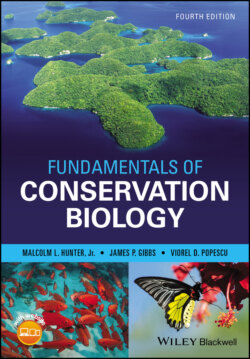Читать книгу Fundamentals of Conservation Biology - Malcolm L. Hunter Jr. - Страница 22
A Brief History of Conservation Biology
ОглавлениеThe deepest, longest roots of conservation biology are widespread but its emergence as a discipline is usually attributed to the First International Conference on Conservation Biology held in San Diego, California, in 1978, and to the book that followed, Conservation Biology (Soulé and Wilcox 1980). Eight years after this small beginning the Society for Conservation Biology was formed, and it launched a new journal, Conservation Biology, in 1987 (Fig. 1.5). The society and its journal flourished, and universities, foundations, private conservation groups, and government agencies nurtured this growth with an array of conservation biology programs (Jacobson 1990 ; Meine et al. 2006).
Figure 1.5 The Society for Conservation Biology began publishing Conservation Biology in May 1987 and held its first conference that June.
The founders of conservation biology had many more links to institutions of basic biological sciences (e.g. genetics, zoology, botany) than to natural resource management institutions and they wove some novel and diverse intellectual threads into the discipline’s tapestry. Ideas from evolutionary biology, population dynamics, landscape ecology, and biogeography provided a new understanding of the diversity of life, its origins and maintenance, how it is distributed around the globe, and what threatens it.
By forming a new professional society dedicated to the maintenance of biological diversity, conservation biologists partly overlapped the domain of some older professional societies. This was especially true of The Wildlife Society, which, on the very first page of The Journal of Wildlife Management, described wildlife management as “part of the greater movement for conservation of our entire native flora and fauna” (Bennitt et al. 1937). Today wildlife managers place an ever‐growing emphasis on endangered and nongame species, including reptiles, amphibians, and sometimes even invertebrates and plants. However, much of their attention, arguably most, is still focused on “game” species, in large part because most of the funding for wildlife management agencies comes from the fees hunters and anglers are required to pay. Perhaps, if more wildlife managers had reached out to embrace all forms of life that are wild, not just the vertebrates, and to work with a constituency of all people who care about nature, not just hunters and anglers, then conservation biology might never have arisen as a separate discipline. This is especially apparent if one defines “wildlife” as “all forms of life that are wild,” a definition that overlaps substantially with biodiversity. Notably, the first institution to apply science to conservation was the “Roosevelt Wild Life Station,” established in 1919 to integrate science, natural history, and natural resources management for training a new generation of students to implement this new idea of “conservation” of “wild life.” To be clear that this book uses a broad definition, we retain the original, two‐word spelling, “wild life.” As you can see, these terms “wildlife,” “wild life,” “biological diversity,” and “biodiversity” have a long and inter‐related history and still remain in use in different contexts.
